Ancient India developed remarkably effective spice storage methods you can still use today. You'll find clay pots provide natural cooling and moisture control, while sun-dried earthenware vessels regulate humidity perfectly. Traditional bamboo baskets offer excellent airflow and natural pest resistance. Neem leaf layering protects spices from insects while preserving flavor. Sacred coconut shells serve as lightweight, durable containers that prevent light damage. Silver vessels combat bacteria with their antimicrobial properties, and stone grinders double as storage tools with natural preservation qualities. These time-tested techniques hold centuries of wisdom waiting to enhance your modern kitchen.
Clay Pot Storage Systems
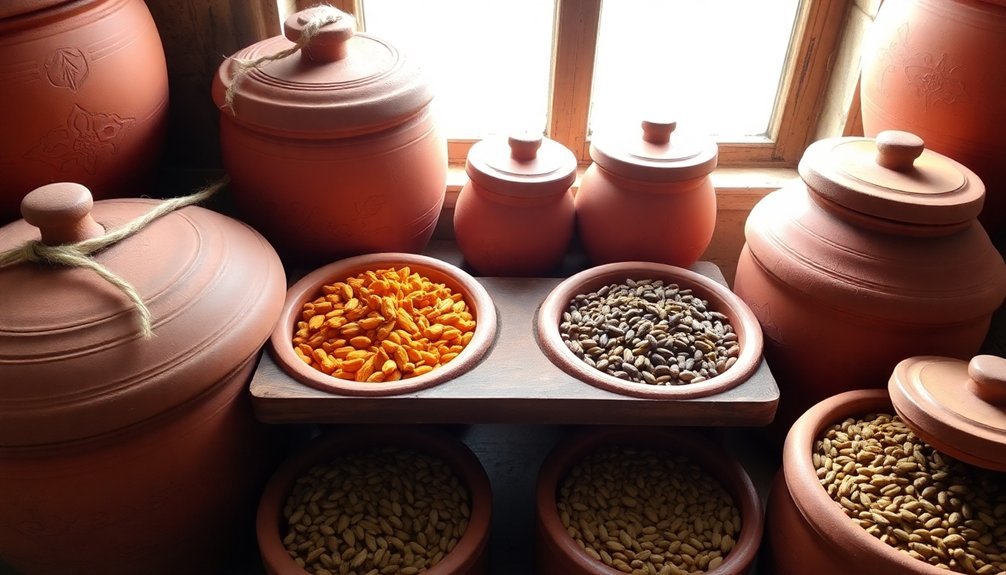
In accordance with ancient Indian traditions, clay pot storage systems offer a remarkably effective method for preserving spices. You'll find that clay pots provide natural cooling and superior moisture control through their porous structure, which allows your spices to maintain their rich flavors and aromas longer.
The breathable nature of clay prevents dampness from accumulating while keeping your spices fresh. Even heat distribution makes these vessels ideal for maintaining consistent temperatures throughout your spice collection.
To prepare your clay pot for spice storage, you'll need to soak it in water for 12-24 hours, then bake it at 300°F for 2-3 hours. After baking, apply a thin layer of oil to the interior surfaces to enhance durability.
You can choose from various types of clay containers, including traditional matkas, handis, or smaller clay jars designed specifically for spice storage.
You'll appreciate that clay pots are chemically inert, guaranteeing your spices won't react with the container material.
When maintaining your clay storage system, use only mild detergent and warm water for cleaning, and always guarantee thorough drying before use.
This sustainable storage method not only preserves your spices effectively but also connects you to centuries-old traditions of the Indus Valley Civilization.
Neem Leaf Layering Technique
Beyond clay pot storage, ancient Indian wisdom offers another remarkable spice preservation method: the neem leaf layering technique. You'll need both fresh and dried neem leaves to effectively protect your spices from insects while maintaining their original flavor and aroma.
Start by creating alternating layers in your storage container, beginning with a 1.5 cm layer of fresh neem leaves, followed by 30 cm of sun-dried spices. Continue this pattern until you've filled the container, guaranteeing you finish with a protective neem leaf layer on top. For enhanced protection, you can also apply a neem plaster to your container's interior walls. Shade-dried neem leaves maintain their insect-repelling properties better than sun-dried alternatives.
Here's how to maximize the neem leaf method's effectiveness:
- Mix 1-2 kg of dried neem leaf powder with every 100 kg of spices for up to 6 months of protection.
- Create a protective plaster by combining dried neem powder with clay and water.
- Store powdered neem leaves in airtight containers to maintain their potency for up to a year.
- Confirm your spices are completely pest-free before storage to guarantee the method's success.
This time-tested technique doesn't affect the taste of your spices and provides a safe, natural preservation solution.
Sun-Dried Earthenware Vessels
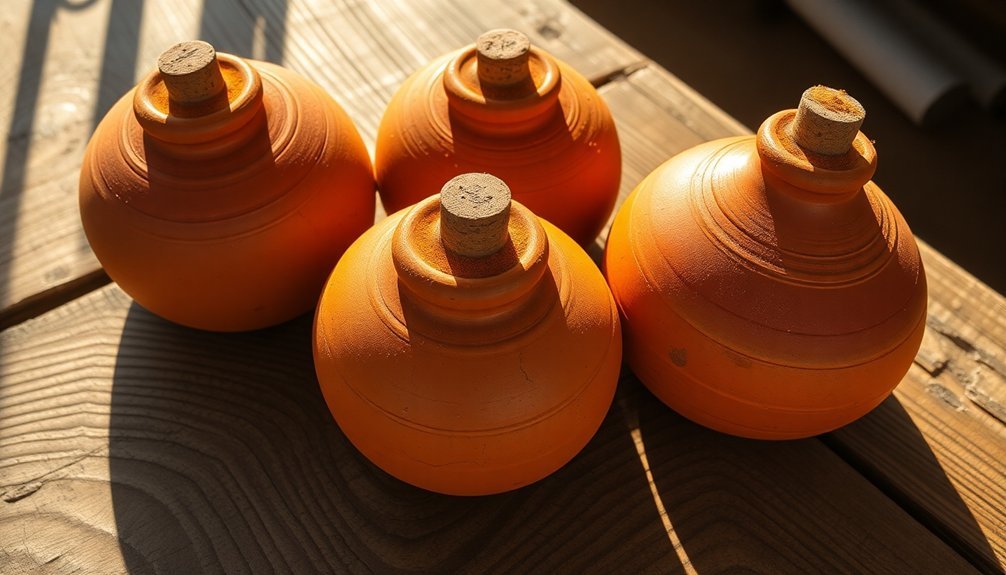
You'll find that sun-dried earthen vessels offer remarkable moisture control through their porous clay structure, keeping your spices dry and fresh for extended periods.
The traditional sunbaking process involves drying the clay pots under direct sunlight for several days, which enhances their ability to regulate humidity and prevent spice deterioration. These vessels, like white and brown jaadis, were traditionally preferred over modern plastic alternatives for their superior preservation qualities.
In Indian villages, these vessels are often stored in elevated positions with neem leaves, combining ancient wisdom of both clay and natural preservatives for ideal spice storage.
Moisture Control Through Clay
While many modern storage solutions rely on synthetic materials, ancient Indians mastered the art of spice preservation through sun-dried clay vessels. Clay's porous nature, particularly prominent in kalchattis from Tamil Nadu and other southern regions, created an ideal environment for storing precious spices.
You'll find that clay vessels weren't just practical storage solutions – they held deep cultural significance, often associated with the goddess of prosperity and harvest. The vessels' ability to regulate moisture made them invaluable in India's diverse climate, especially in southern and western regions where humidity could pose a threat to spice preservation.
Here's how clay vessels protected your spices:
- The porous structure allowed natural moisture regulation, keeping spices dry
- Clay's breathable nature prevented condensation from forming inside
- The material's properties maintained consistent humidity levels
- The vessels' composition blocked environmental moisture from seeping in
You'll appreciate how these earthenware containers merged practicality with cultural significance, serving both as effective storage solutions and symbols of purity.
In many Indian households, these vessels weren't just containers – they represented a sophisticated understanding of natural preservation methods passed down through generations.
Traditional Sunbaking Process
Since ancient times, the sunbaking process for earthenware vessels has remained a cornerstone of Indian spice preservation. You'll find that craftsmen begin by selecting clay from local sources, particularly in southern and western India, choosing materials known for their porous qualities. The clay's connection to the goddess of prosperity adds spiritual significance to these vessels.
The process starts with cutting clay into strips and rolling them out to create the desired form. You'll need to let the vessels dry in the sun for several days, a vital step that develops the proper porosity and durability. The sun-drying technique guarantees that your vessel can effectively "exhale" carbon dioxide, which is essential for spice preservation.
Once dried, you'll notice these vessels feature intricate designs and cultural motifs, especially in traditional forms like Tamil Nadu's kalchattis.
When you're storing spices, you'll want to keep these containers in cool, dry places, away from direct sunlight and moisture. The vessel's porous nature helps your spices stay fresh longer while maintaining consistent temperatures, similar to the effectiveness of underground storage methods used in ancient times.
Village Storage Techniques
Building upon these ancient sunbaking methods, Indian villages developed sophisticated storage systems for their spices using earthenware vessels.
You'll find that clay was particularly favored in southern and western India, where its porous nature helped keep spices dry and fresh. The material choice wasn't random – villages selected containers based on what was locally available and culturally significant.
These traditional storage techniques followed specific principles to maintain spice quality:
- You'd need to store your spices in airtight containers, typically handcrafted clay kalchattis in Tamil Nadu, to prevent moisture from seeping in.
- You should keep your spice containers in cool, dark places away from direct sunlight to preserve their potency.
- You must maintain a dry environment to prevent clumping and mold growth.
- You'll want to use opaque or tinted containers to protect spices from light exposure.
The vessels weren't just functional – they often featured intricate designs that reflected local craftsmanship traditions.
In regions like Kerala, you'd find coconut shell containers, while Kashmir and Gujarat were known for their expertly carved wooden spice boxes. These choices weren't merely practical; they represented the deep connection between cultural heritage and daily life.
Sacred Coconut Shell Containers
Throughout ancient India's rich culinary history, coconut shell containers held a sacred place in spice storage traditions, especially in Kerala where they're known as vessels of the Kalpavriksha (tree of life).
You'll find these containers deeply woven into the region's cultural fabric, where local communities have mastered the art of utilizing every part of the coconut tree.
When you store your spices in coconut shells, you're tapping into centuries-old wisdom. The shells naturally protect your spices from moisture and sunlight, two elements that can quickly degrade the essential oils and flavors of your precious seasonings.
You won't need any additional materials or processing – just clean, dried shells that craftsmen have carefully shaped.
You're also participating in a sustainable tradition that's been passed down through generations.
These containers are incredibly practical – they're lightweight, durable, and easy to handle in your daily cooking routine.
If you're looking to maintain the freshness of your spices, you'll appreciate how the shells create a natural barrier against environmental factors, helping preserve your spices' potency and flavor for longer periods.
Silver Container Preservation Method
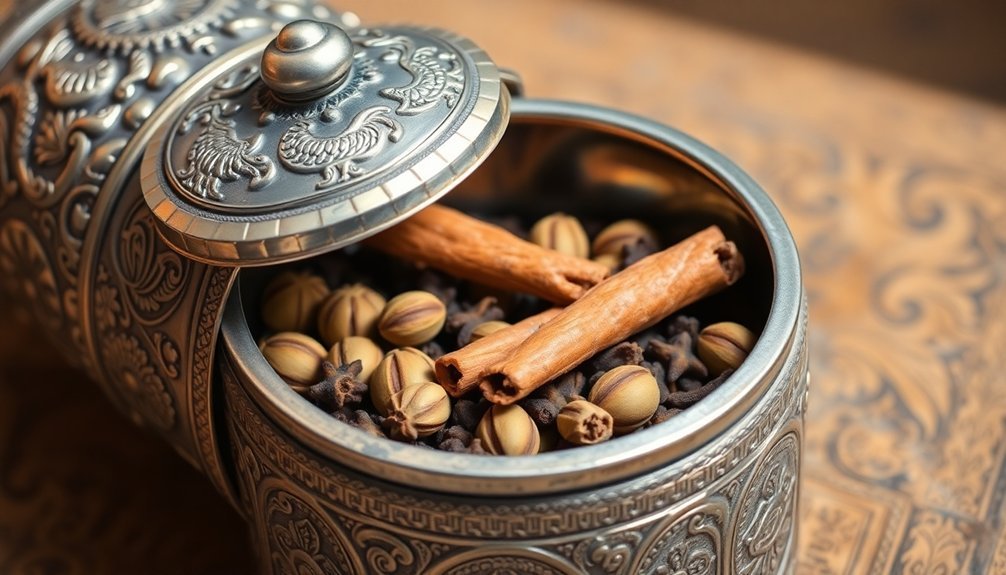
In ancient India, you'd find exquisite silver containers gracing royal households, where they served as the preferred method for storing precious spices and displaying wealth.
These containers weren't just beautiful showpieces – their natural antimicrobial properties kept spices fresh and protected from moisture, mold, and bacteria.
From ornate spice boxes (masaladani) to intricate storage vessels (kalash), these silver containers combined practical preservation with stunning craftsmanship through detailed engravings and traditional motifs.
Historical Royal Storage Practices
Ancient Indian royalty pioneered sophisticated spice storage methods, with silver containers standing out as their most prestigious choice. You'll find that these containers weren't just about luxury – they served vital preservation purposes while reflecting the grandeur of royal courts.
The royal households relied on silver containers for their most valuable spices, combining both practical and ceremonial functions. You'd see these containers adorned with intricate designs, featuring a stunning fusion of Mughal and Indian artistry through detailed engravings and Arabic calligraphy.
The royal storage practices followed strict protocols that guaranteed maximum preservation:
- Precious spices like saffron, cardamom, and cloves were stored in separate silver containers to maintain their distinct flavors.
- The containers were kept in cool, dark places within the royal kitchens to prevent degradation.
- Each container was specifically designed with airtight seals to protect against moisture and contamination.
- Regular cleaning and maintenance guaranteed the silver's natural antimicrobial properties remained effective.
These royal storage methods weren't just about preservation – they were deeply embedded in cultural traditions, often playing significant roles in religious ceremonies and spiritual practices within the palace walls.
Antimicrobial Benefits Of Silver
Silver containers weren't just status symbols in royal households – their scientific properties made them exceptional preservation tools. When spices come into contact with silver surfaces, silver ions are released that actively fight against harmful bacteria. These ions work by attaching to bacterial cell membranes, making them more permeable and vulnerable to damage.
You'll find that silver's antimicrobial action is quite thorough. It disrupts bacterial DNA, prevents cell division, and generates reactive oxygen species that cause bacterial death. This multi-pronged approach makes it particularly effective at preserving spices long-term.
If you're storing valuable spices, silver's stability makes it an ideal container material. It doesn't react with most spices and continues to release protective ions over extended periods.
Modern research has shown that silver nanoparticles can greatly reduce total microbial count, including molds and harmful bacteria like E. coli.
You can still benefit from this ancient wisdom today. While pure silver containers might be expensive, they're incredibly effective at maintaining spice quality without adding harmful chemicals or preservatives. The antimicrobial properties help preserve both the flavor and safety of your stored spices.
Traditional Silver Container Types
Traditional Indian households commonly featured distinct types of silver spice containers, each crafted for specific storage needs.
You'll find these containers were more than just functional items – they represented status and cultural heritage, particularly in royal households where they symbolized wealth and divine blessings.
The most prevalent silver container types included:
- Masala Daani – A multi-compartment box with separate sections for daily-use spices, featuring intricate floral engravings and traditional Mughal designs.
- Betel Boxes (Paan Daan) – Elaborate containers with dedicated spaces for betel leaves, areca nuts, and accompaniments, often adorned with Arabic calligraphy.
- Spice Towers (Masala Minar) – Vertical stacked containers that saved counter space while storing different spices in tiers.
- Individual Spice Holders – Small, intricately designed containers for specific precious spices like saffron or cardamom.
You'll notice these containers weren't just aesthetically pleasing – they were engineered to protect spices from environmental factors like light, heat, and moisture.
The craftsmanship varied by region, with each area developing its own signature style while maintaining silver's essential preservation properties.
Bamboo Basket Storage
Throughout India's rich history, bamboo baskets emerged as a masterful solution for storing precious spices. You'll find these lightweight containers were particularly prominent in eastern regions like Assam, where bamboo grew abundantly and local artisans developed specialized weaving techniques.
You can appreciate how the natural properties of bamboo made it an ideal storage solution. The material's inherent resistance to pests and fungi helped protect valuable spices, while its porous nature allowed proper airflow to prevent moisture buildup. When storing your spices in bamboo baskets, you'd typically wrap them in cloth or paper first, then place them in a cool, dry location.
What's fascinating is how these baskets reflected local cultural traditions. Each region developed its unique designs and patterns, and communities passed down basket-making skills through generations.
You'll notice that the baskets' sizes and shapes varied depending on the specific spices they'd hold. To maintain their effectiveness, you'd need to treat the baskets with natural oils or herbs, keeping them clean and well-maintained. This sustainable storage method exemplified the practical wisdom of ancient Indian communities.
Traditional Stone Grinding Storage
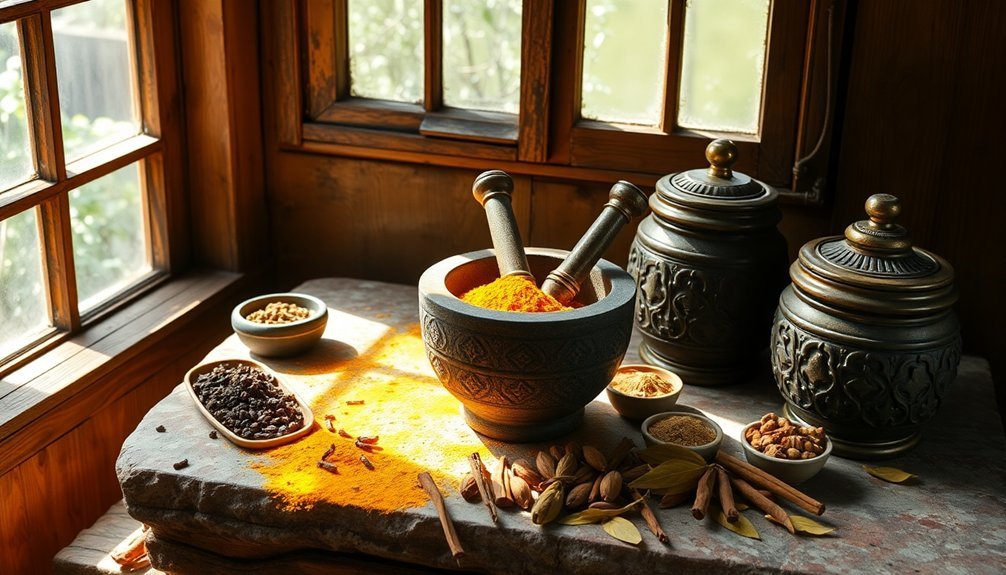
In ancient India, stone grinding tools played a dual role as both processing and storage equipment for precious spices. These limestone and granite implements weren't just for grinding; they helped preserve the freshness and potency of spices through their natural mineral properties.
When you're storing spices in traditional stone grinders, you'll want to follow these time-tested methods:
- Clean your stone thoroughly with warm water and dry completely to prevent moisture from affecting your spices.
- Sprinkle a thin layer of salt on the stone's surface before adding your spices, as it creates a protective barrier.
- Store only compatible spices together, such as dry aromatics like coriander and cumin.
- Keep your grinding stones in a cool, dry place away from direct sunlight.
The calcium-rich limestone construction of these tools doesn't just store your spices; it actually enriches them with essential minerals.
You'll find that spices stored in traditional stone grinders maintain their aroma longer than those kept in modern containers. This storage method's effectiveness has been proven through centuries of use across South and Southeast Asia, where it's still practiced in many households today despite the availability of modern alternatives.
Frequently Asked Questions
How Did Ancient Indians Test the Quality of Spices Before Storage?
You'd test spices by trusting your senses – checking for strong aromas, examining labels for purity, and feeling the texture on your fingertips. You'd also verify they're fresh before storing them properly.
What Cleaning Rituals Were Performed Before Storing Spices in Traditional Containers?
You won't find specific cleaning rituals documented for ancient Indian spice storage containers. While they used clay, silver, and wooden containers, the focus was mainly on keeping storage areas dry and maintaining container cleanliness.
Did Seasonal Changes Affect Traditional Indian Spice Storage Methods?
Yes, you'll find Indians adjusted their spice storage based on seasons. You'd switch containers during monsoons to combat humidity, move spices away from heat in summer, and guarantee proper ventilation year-round.
Which Spices Were Considered Too Sacred to Store With Common Ones?
You'll find saffron, pure cardamom, and holy turmeric were typically stored separately in silver containers. These spices held immense religious significance and couldn't be mixed with everyday spices in traditional Indian households.
How Did Ancient Traders Transport Spices While Maintaining Their Freshness?
You'll find traders used airtight containers, cloth pouches, and sealed wooden boxes while transporting spices. They'd rely on strategic port selections and aromatic properties to maintain freshness during their long sea and land journeys.
In Summary
You'll find these time-tested Indian spice storage methods incredibly effective for modern use. Whether you're using clay pots, neem leaves, or coconut shells, these traditional techniques help preserve your spices' aroma and potency for months. While some materials might be harder to source today, you can adapt these principles using similar alternatives. Try incorporating these ancient wisdom-backed storage methods into your kitchen routine.

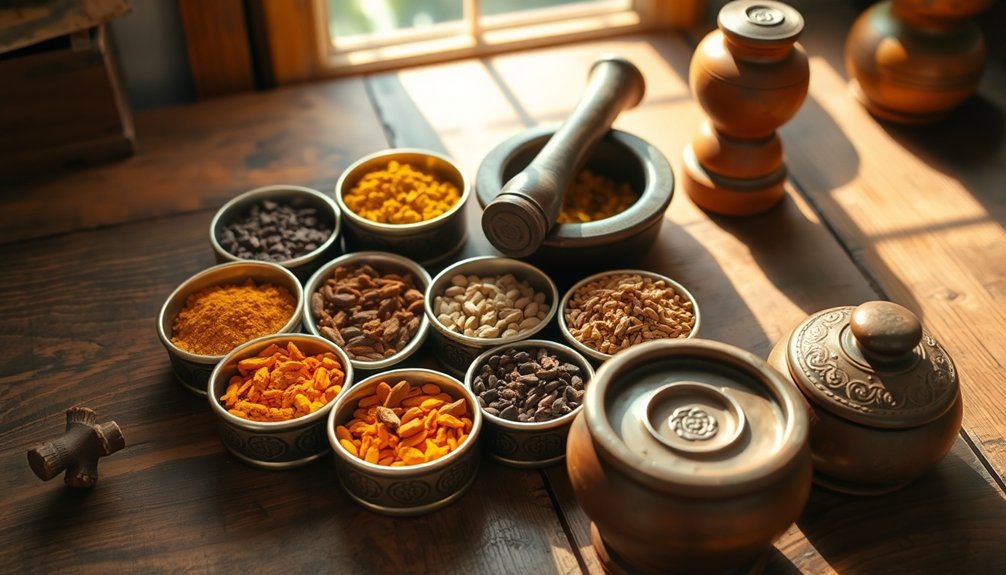



Leave a Reply